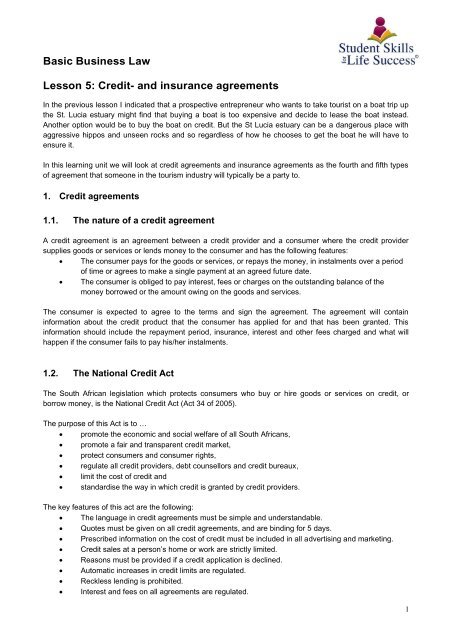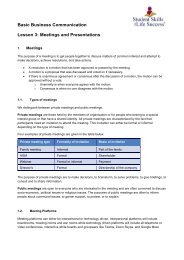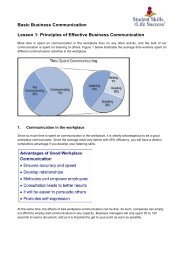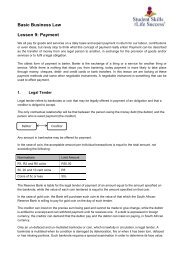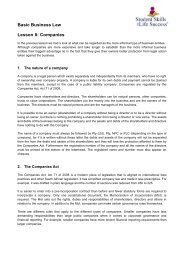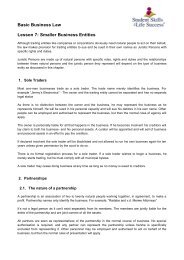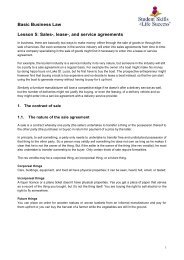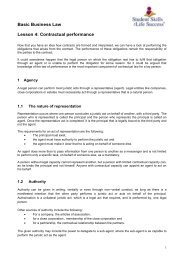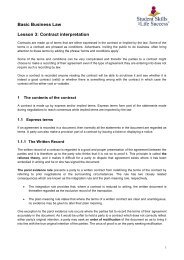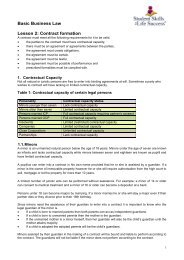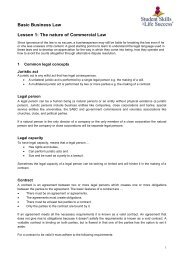Basic Business Law. Lesson 6. Credit- and insurance agreements
This is the sixth lesson of the "Student Skills for Life Success" "Basic Business Law" course. The topics covered in this booklet are: 1. Credit agreements 2. Insurance agreements
This is the sixth lesson of the "Student Skills for Life Success" "Basic Business Law" course. The topics covered in this booklet are:
1. Credit agreements
2. Insurance agreements
Create successful ePaper yourself
Turn your PDF publications into a flip-book with our unique Google optimized e-Paper software.
<strong>Basic</strong> <strong>Business</strong> <strong>Law</strong><br />
<strong>Lesson</strong> 5: <strong>Credit</strong>- <strong>and</strong> <strong>insurance</strong> <strong>agreements</strong><br />
In the previous lesson I indicated that a prospective entrepreneur who wants to take tourist on a boat trip up<br />
the St. Lucia estuary might find that buying a boat is too expensive <strong>and</strong> decide to lease the boat instead.<br />
Another option would be to buy the boat on credit. But the St Lucia estuary can be a dangerous place with<br />
aggressive hippos <strong>and</strong> unseen rocks <strong>and</strong> so regardless of how he chooses to get the boat he will have to<br />
ensure it.<br />
In this learning unit we will look at credit <strong>agreements</strong> <strong>and</strong> <strong>insurance</strong> <strong>agreements</strong> as the fourth <strong>and</strong> fifth types<br />
of agreement that someone in the tourism industry will typically be a party to.<br />
1. <strong>Credit</strong> <strong>agreements</strong><br />
1.1. The nature of a credit agreement<br />
A credit agreement is an agreement between a credit provider <strong>and</strong> a consumer where the credit provider<br />
supplies goods or services or lends money to the consumer <strong>and</strong> has the following features:<br />
• The consumer pays for the goods or services, or repays the money, in instalments over a period<br />
of time or agrees to make a single payment at an agreed future date.<br />
• The consumer is obliged to pay interest, fees or charges on the outst<strong>and</strong>ing balance of the<br />
money borrowed or the amount owing on the goods <strong>and</strong> services.<br />
The consumer is expected to agree to the terms <strong>and</strong> sign the agreement. The agreement will contain<br />
information about the credit product that the consumer has applied for <strong>and</strong> that has been granted. This<br />
information should include the repayment period, <strong>insurance</strong>, interest <strong>and</strong> other fees charged <strong>and</strong> what will<br />
happen if the consumer fails to pay his/her instalments.<br />
1.2. The National <strong>Credit</strong> Act<br />
The South African legislation which protects consumers who buy or hire goods or services on credit, or<br />
borrow money, is the National <strong>Credit</strong> Act (Act 34 of 2005).<br />
The purpose of this Act is to …<br />
• promote the economic <strong>and</strong> social welfare of all South Africans,<br />
• promote a fair <strong>and</strong> transparent credit market,<br />
• protect consumers <strong>and</strong> consumer rights,<br />
• regulate all credit providers, debt counsellors <strong>and</strong> credit bureaux,<br />
• limit the cost of credit <strong>and</strong><br />
• st<strong>and</strong>ardise the way in which credit is granted by credit providers.<br />
The key features of this act are the following:<br />
• The language in credit <strong>agreements</strong> must be simple <strong>and</strong> underst<strong>and</strong>able.<br />
• Quotes must be given on all credit <strong>agreements</strong>, <strong>and</strong> are binding for 5 days.<br />
• Prescribed information on the cost of credit must be included in all advertising <strong>and</strong> marketing.<br />
• <strong>Credit</strong> sales at a person’s home or work are strictly limited.<br />
• Reasons must be provided if a credit application is declined.<br />
• Automatic increases in credit limits are regulated.<br />
• Reckless lending is prohibited.<br />
• Interest <strong>and</strong> fees on all <strong>agreements</strong> are regulated.<br />
1
• <strong>Credit</strong> Bureaux are regulated <strong>and</strong> consumers have the right to a free<br />
credit bureaux record.<br />
• Debt counselling is introduced, to enable the restructuring of debts for over-indebted consumers.<br />
1.3. The National <strong>Credit</strong> Regulator <strong>and</strong> the National <strong>Credit</strong> Tribunal<br />
The National <strong>Credit</strong> Acts introduces a National <strong>Credit</strong> Regulator <strong>and</strong> a National Consumer Tribunal.<br />
The functions of the National <strong>Credit</strong> Regulator are to …<br />
• register credit providers, credit bureaux <strong>and</strong> debt counsellors, <strong>and</strong> monitor them,<br />
• educate <strong>and</strong> create awareness of the consumer protection under the Act,<br />
• research the credit market <strong>and</strong> monitor access to credit <strong>and</strong> the cost of credit,<br />
• identify factors that may undermine access to credit, competitiveness <strong>and</strong> consumer protection,<br />
• advise government on policy <strong>and</strong> legislation,<br />
• receive <strong>and</strong> investigate complaints,<br />
• ensure that consumer rights are protected <strong>and</strong><br />
• enforce the Act <strong>and</strong> act against contravening institutions.<br />
The National Consumer Tribunal hears cases on non-compliance with the Act, issues fines <strong>and</strong> provides<br />
compensation to consumers. Consumers <strong>and</strong> credit providers may appeal to the Tribunal against any<br />
decision of the National <strong>Credit</strong> Regulator. The Tribunal is independent of the National <strong>Credit</strong> Regulator <strong>and</strong><br />
consists of a Chairperson <strong>and</strong> at least 10 other members.<br />
Consumers can approach the National <strong>Credit</strong> Regulator for advice or assistance on any transaction falling<br />
under the Act. The National <strong>Credit</strong> Regulator can also assist consumers on issues related to credit bureaux<br />
or credit information.<br />
1.4. Types of credit <strong>agreements</strong><br />
All of the following transactions are regarded as credit <strong>agreements</strong>.<br />
1.4.1. Instalment sale <strong>agreements</strong><br />
This is the sale of movable property where the payment is made by way of periodic payments. Interest, fees<br />
or charges are payable to the credit provider by the consumer who possesses or uses the property.<br />
Ownership of the property passes on to the consumer at the end of the credit agreement period.<br />
1.4.2. Mortgage <strong>agreements</strong><br />
An agreement in terms of which credit is secured by way of security in the form of a pledge of immovable<br />
property, such as a home loan secured by way of a bond over the property<br />
1.4.3. Leases<br />
Temporary possession of movable property <strong>and</strong> payments are made for its usage. Interest, fees <strong>and</strong> charges<br />
are payable <strong>and</strong> the consumer has the option of having the ownership transferred at the end of the<br />
agreement.<br />
1.4.4. <strong>Credit</strong> guarantee <strong>agreements</strong><br />
<strong>Credit</strong> guarantee with one person where this person promises to pay a debt incurred by another consumer<br />
upon receiving a dem<strong>and</strong> from the credit provider.<br />
2
1.4.5. Loans<br />
Loans include micro-loans <strong>and</strong> other credit from banks or credit providers including<br />
overdrafts, credit cards, vehicle finance <strong>and</strong> personal loans as well as furniture finance, clothing accounts<br />
<strong>and</strong> any other type of credit from retailers.<br />
1.4.<strong>6.</strong> Pawn transactions<br />
A pawn agreement is a small credit agreement where a personal article is used as collateral. The pawn shop<br />
will keep <strong>and</strong> be responsible for the thing pawned until the customer repays the loan with the agreed interest.<br />
1.4.7. Developmental credit<br />
Developmental credit is a special type of credit that is created <strong>and</strong> defined in the National <strong>Credit</strong> Act. There<br />
are three types of developmental credit i.e. loans for educational purposes, loans to build, exp<strong>and</strong> or improve<br />
low-cost housing <strong>and</strong> loans to set up small-<strong>and</strong> medium-sized businesses.<br />
1.4.8. Incidental credit<br />
When the original agreement for the sale of goods <strong>and</strong> services is entered into, between any supplier <strong>and</strong><br />
consumer the intention is not to extend credit to the consumer. In other words it is not a credit agreement,<br />
but due to the consumers’ failure to pay for the goods or services on or before a determined date, a fee,<br />
charge or interest is added to the amount due. The agreement is now referred to as an incidental credit<br />
agreement. An example of incidental credit would be an overdue municipal account or an overdue doctor’s<br />
account.<br />
1.4.9. Agreements which are not covered by the Act<br />
The following <strong>agreements</strong> are not regarded as credit <strong>agreements</strong>:<br />
• Agreements where the credit provider <strong>and</strong> the consumer are related, for example where a<br />
husb<strong>and</strong> lends money to his wife;<br />
• Agreements where a member of a stokvel borrows money from the stokvel;<br />
• Agreements where the director of a company lends money to his company;<br />
• Agreements where a government institution lends or borrows money from any source. For<br />
example where a commercial bank borrows money from the South African Reserve Bank.<br />
1.5. The rights of the credit seeker<br />
1.5.1. The right to apply for credit.<br />
Every legal person has the right to apply for credit from any credit provider. The credit provider may grant the<br />
credit or can refuse to grant the credit. The reason for refusing to grant the credit must be based on business<br />
grounds that are in line with the normal credit risk evaluation processes of the credit provider.<br />
A credit risk evaluation is an assessment done by a credit provider to decide whether or not credit will be<br />
granted to a consumer, what level of bad debt can be expected, <strong>and</strong> what level of risk will be acceptable to<br />
justify the profit made.<br />
1.5.2. The right not to be discriminated against when applying for credit<br />
Consumers who are applying for credit are protected against unfair discrimination by a credit provider.<br />
Discriminating against consumers on the basis of colour, race, age, political affiliation, sexual orientation,<br />
religious belief, or affiliation to any particular trade union is not allowed.<br />
3
A consumer who is of the opinion that he/she has been discriminated against for<br />
these reasons may act against the credit provider through the Equality Court, or may<br />
complain to the National <strong>Credit</strong> Regulator which will refer the matter to the Equality Court.<br />
1.5.3. The right to be given reasons for credit being declined.<br />
A consumer, whose credit application has been declined by a credit provider, has the right to request written<br />
reasons explaining why the application for credit has been declined. If the decision to decline the consumer's<br />
request is based on an unfavourable report received from a credit bureau, then the credit provider must<br />
supply the consumer in writing with the name, address <strong>and</strong> other contact details of the credit bureau from<br />
which the information was received.<br />
<strong>Credit</strong> bureaux are entities that retain <strong>and</strong> disclose personal credit information for payment. They investigate<br />
credit applications, credit <strong>agreements</strong> <strong>and</strong> the payment history <strong>and</strong> payment patterns of the credit seeker<br />
using data from reports containing the above.<br />
1.5.4. The right to be given documents in an official language that the consumer underst<strong>and</strong>s<br />
A consumer has the right to receive documents from a credit provider in an official language that he/she<br />
underst<strong>and</strong>s. Documents that a credit provider must give to a consumer include the credit agreement,<br />
quotations <strong>and</strong> statements.<br />
A credit provider can make a proposal to the National <strong>Credit</strong> Regulator (NCR) on the languages in which it<br />
intends making its documents available if it’s unpractical or unreasonable to make it available in all official<br />
languages. The NCR will approve these proposals if they are reasonable.<br />
1.5.5. The right to be given documents in plain <strong>and</strong> underst<strong>and</strong>able language<br />
A consumer has the right to receive information <strong>and</strong> documents in plain language. This means that the<br />
contents, meaning <strong>and</strong> importance of the document must be easy to underst<strong>and</strong>. The NCR may issue<br />
guidelines to indicate what would be regarded as “plain language”.<br />
1.5.<strong>6.</strong> The right to be given documents related to the credit transaction<br />
A consumer has the right to receive documents relating to the credit agreement in a manner that the<br />
consumer chooses. A consumer may choose to receive documents in person, at the credit provider's place<br />
of business, or by fax, email, or by a printable web page.<br />
A consumer has the right to receive one replacement copy of documents from the credit provider. If the<br />
replacement copy is requested within a year of the delivery of the original documents it will be free of charge.<br />
The consumer will be expected to pay the credit provider for additional replacement documents<br />
A consumer must be given a pre-agreement statement <strong>and</strong> a quotation before entering into a credit<br />
agreement with a credit provider. A pre-agreement statement is a document which details the terms <strong>and</strong><br />
conditions of the credit agreement that the credit provider intends entering into with the consumer. The<br />
quotation must disclose the costs of the credit required including the principal debt, the interest rate, the total<br />
amount payable, the instalments <strong>and</strong> all fees, charges <strong>and</strong> interest. The quotation that the consumer<br />
receives is valid for five business days.<br />
4
1.5.7. The right to confidential treatment<br />
Any person or organisation that receives or compiles confidential information on a<br />
consumer must use the information for the sole purpose for which the consumer has given his/her consent,<br />
unless the usage or release of such information is a requirement in terms of The Act. The person or<br />
organisation holding the consumer's confidential information may only release it as specifically instructed by<br />
the consumer or by a court of law.<br />
1.5.8. The right to access <strong>and</strong> challenge information held by a credit bureau.<br />
The consumer has the right to access information that a credit bureau has in relation to him/her. The<br />
information must be given to the consumer free of charge every twelve months or for a fee if the consumer<br />
requests the information more than once within twelve months. Such a fee may not exceed R20.00. A<br />
consumer may challenge <strong>and</strong> request proof of the accuracy of the information held by a credit bureaux<br />
The credit provider must advise the consumer before certain adverse information about that consumer is<br />
passed on to a credit bureau. The consumer is also entitled to receive a copy of that information on request.<br />
1.5.9. The right to receive periodic statements<br />
A credit provider must provide a consumer with a statement once a month or once every two months if the<br />
agreement is an instalment sale agreement, lease or secured loan, but a 3-month interval may be agreed<br />
between the parties. With regards to a mortgage agreement the consumer is entitled to receive a statement<br />
every six months.<br />
1.5.10. The right to settle the agreement early<br />
The consumer may settle an agreement at any time before the date specified in the agreement <strong>and</strong> is not<br />
obligated to give the credit provider notice that he/she intends to settle the credit agreement early.<br />
In the case of a large agreement, when a consumer exercises this right, he/ she will be charged an early<br />
settlement amount. This right is also available to a guarantor. A guarantor is a person who agrees to pay a<br />
debt, which is due to a credit provider by another consumer should the consumer fail to pay the credit<br />
provider.<br />
1.<strong>6.</strong> The cost of credit<br />
1.<strong>6.</strong>1. Interest<br />
Interest is the amount that a credit provider charges a consumer on the outst<strong>and</strong>ing balance of a credit<br />
agreement. This amount is calculated by multiplying the principal amount with a percentage, called the<br />
interest rate. This interest rate must be reflected on the credit agreement.<br />
1.<strong>6.</strong>2. Initiation fees<br />
The initiation fee is the fee that a credit provider charges a consumer for entering into a credit agreement. It<br />
will only be payable if indeed the consumer <strong>and</strong> the credit provider enters into the agreement <strong>and</strong> may never<br />
exceed 15% of the loan amount. - The maximum interest rates <strong>and</strong> initiation fees per type of credit<br />
agreement is given in the table 1.<br />
1.<strong>6.</strong>3. Default administration charges<br />
This is a charge that a credit provider may charge a consumer who is in arrears with repayments on his/her<br />
credit agreement. These charges relate to costs that the credit provider has incurred in attempting to advise<br />
the consumer that he/she is in arrears with his/her account.<br />
5
1.<strong>6.</strong>4. Collection costs.<br />
Collection costs are costs that the credit provider incurs when attempting to collect<br />
an outst<strong>and</strong>ing, overdue debt from the consumer.<br />
The in-duplum-rule states that once a consumer is in default, arrears interest may never exceed the<br />
outst<strong>and</strong>ing capital balance owed at the time of default.<br />
Table 1: Maximum interest rates <strong>and</strong> initiation fees<br />
Type of credit agreement Maximum interest rate Maximum initiation fee<br />
Mortgages <strong>and</strong> Bond (REPO rate x 2.2) +5%<br />
<strong>Credit</strong> cards <strong>and</strong> Store cards (REPO rate x 2.2) + 10%<br />
Personal loans <strong>and</strong> other<br />
unsecured credit<br />
(REPO rate x 2.2) +20%<br />
R1000 + 10% of amount more than<br />
R10 000 to a maximum of R5000<br />
R150 + 10% of the amount more than<br />
R1000 to a maximum of R1000<br />
R150 + 10% of the amount more than<br />
R1000 to a maximum of R1000<br />
Incidental <strong>Credit</strong> 2% per month NA<br />
Small & medium business loans (REPO rate x 2.2) +20%<br />
Low-income housing loans (REPO rate x 2.2) +20%<br />
Short term loans<br />
5% per month<br />
Other unspecified loans (REPO rate x 2.2) + 10%<br />
R250 + 10% of the amount more than<br />
R1000 to a maximum of R2500<br />
R500 + 10% of the amount more than<br />
R1000 to a maximum of R2500<br />
R150 + 10% of the amount more than<br />
R1000 to a maximum of R1000<br />
R150 + 10% of the amount more than<br />
R1000 to a maximum of R1000<br />
6
2. Insurance <strong>agreements</strong><br />
2.1. The nature of an <strong>insurance</strong> contract<br />
The basis of <strong>insurance</strong> in South Africa is the <strong>insurance</strong> contract. An <strong>insurance</strong> contract (other than in life<br />
<strong>insurance</strong>) is a reciprocal contract between an insurer <strong>and</strong> an insured in terms of which the insurer<br />
undertakes to pay the insured an amount of money, in exchange for payment of a monetary premium, should<br />
the risk borne by the insurer on behalf of the insured, materialise by the happening of an event in which the<br />
insured has an interest.<br />
Both Roman-Dutch <strong>and</strong> English law are considered to be the primary common law sources of South African<br />
<strong>insurance</strong> law. The three most important pieces of <strong>insurance</strong> legislation are the Long-term Insurance Act 52<br />
of 1998, the Short-term Insurance Act 53 of 1998 <strong>and</strong> the Financial Advisory <strong>and</strong> Intermediary Services Act,<br />
2002 (‘FAIS Act’).<br />
2.2. Different types of <strong>insurance</strong><br />
2.2.1. Capital <strong>insurance</strong> (non-indemnity <strong>insurance</strong>)<br />
Capital <strong>insurance</strong> relates to instances were a specific amount is paid on the happening of a particular event.<br />
In the case of capital <strong>insurance</strong>, the loss suffered, <strong>and</strong> the amount paid by the insurer are not necessarily<br />
proportionate. Life <strong>insurance</strong> is typically capital <strong>insurance</strong> in nature.<br />
Example<br />
R<strong>and</strong>y Rockclimber’s life is insured for one million r<strong>and</strong>. He is currently 25 years old. During the negotiation<br />
process he disclosed all information <strong>and</strong> the insurer is fully aware of his dangerous pastime <strong>and</strong> has loaded<br />
his premium accordingly. He agrees to pay R2 000-00 per month for the cover. He nominates his wife Anna<br />
Anxious as the beneficiary of the policy.<br />
If he dies the day after he bought the policy, the insurer will be obliged to pay his wife the full amount of one<br />
million r<strong>and</strong>. If however he lives to be 100 years old before he dies, his wife, if she is still alive, will still only<br />
be entitled to a payment of one million r<strong>and</strong> regardless of the fact that R<strong>and</strong>y would have paid more than<br />
R1.8M by then.<br />
2.2.2. Indemnity <strong>insurance</strong><br />
Indemnity <strong>insurance</strong> relates to <strong>agreements</strong> where the insurer indemnifies the insured against patrimonial loss<br />
upon the happening of an event described in the policy as the risk insured against. With indemnity <strong>insurance</strong><br />
there is a direct link between the amount insured <strong>and</strong> the actual loss suffered. Table 2 list a number of<br />
indemnity <strong>insurance</strong> products.<br />
Some <strong>insurance</strong> products can either be structured as capital <strong>insurance</strong> or indemnity <strong>insurance</strong> products.<br />
Example<br />
Ricky Racer insures his new car for R200 000-00. During the negotiation process he disclosed all<br />
information. He agrees to pay R2000-00 per month for the cover.<br />
If he is involved in an accident <strong>and</strong> the damage to his car is R20 000, that is what his insurer will pay. If the<br />
car cannot be repaired the insurer will pay out the value of the car.<br />
If it is found that he caused the accident by driving recklessly he would be in breach of contract <strong>and</strong> the<br />
insurer will not have to pay anything.<br />
7
Table 2: Capital <strong>insurance</strong> products<br />
Life <strong>insurance</strong><br />
Disability <strong>insurance</strong><br />
Endowments<br />
Health <strong>insurance</strong><br />
Fund-policies<br />
Investments<br />
A capital amount is paid to the beneficiaries when the insured person dies<br />
A capital amount is paid when the insured person is no longer able to work<br />
A type of life <strong>insurance</strong> policy that pays out if the insured is still alive after a<br />
certain period<br />
Insurance against the risk of incurring medical expenses<br />
Moneys payable from a fund to which the insured contributed over time, like a<br />
retirement fund<br />
Putting money into something with the expectation of gain, usually over a longer<br />
term. More risky but more rewarding than other <strong>insurance</strong> products<br />
Table 3: Indemnity <strong>insurance</strong> products<br />
Motor <strong>insurance</strong><br />
Household <strong>insurance</strong><br />
Indemnity <strong>insurance</strong><br />
Fidelity<br />
Guarantee <strong>insurance</strong><br />
Liability <strong>insurance</strong><br />
Health <strong>insurance</strong><br />
Accident <strong>insurance</strong><br />
Financial protection against physical damage to or theft of motor vehicles<br />
Financial protection against the theft or loss of household items<br />
Insurance against legal action by a third party<br />
Fidelity <strong>insurance</strong> protects organisations from loss of money, securities, or<br />
inventory resulting from crime<br />
Insurance against the non-performance of a party to a contract<br />
Insurance against lawsuits <strong>and</strong> other claims<br />
Insurance against the risk of incurring medical expenses<br />
Additional cover for accidental death <strong>and</strong> disability,<br />
2.2.3. Investment products<br />
Insurers develop investment products <strong>and</strong> structure these on an <strong>insurance</strong> platform. These are more pure<br />
investment products <strong>and</strong> are normally done under a long-term <strong>insurance</strong> license.<br />
2.2.4. Re<strong>insurance</strong><br />
Re<strong>insurance</strong> is where an insurer takes out <strong>insurance</strong> with another insurer that is bigger <strong>and</strong> has more<br />
reserves. For example, after a hailstorm, a local insurer might receive so many claims that if it had to pay out<br />
all of them it would go under, but because the insurer is reinsured for exactly such an event, it will be able to<br />
survive.<br />
8
2.2.5. Mutual <strong>insurance</strong><br />
Mutual <strong>insurance</strong> is where an association of members with a common interest<br />
collectively insure a common interest. For example, a group of stamp collectors form a club <strong>and</strong> display their<br />
collections at a stamp museum. Instead of each collector insuring only his own collection the club might<br />
decide to take out mutual <strong>insurance</strong> to cover the entire exhibition.<br />
2.3. Insurance legislation<br />
2.3.1. Long- <strong>and</strong> Short-term Insurance Acts<br />
The Long-term Insurance Act <strong>and</strong> the Short-term Insurance Act are largely aimed at regulating the insurers<br />
operating in South Africa.<br />
Long-term insurers generally focus on capital <strong>insurance</strong> while short-term insurers focus more on indemnity<br />
products, but more to the extent that such <strong>insurance</strong> relates to the compensation for patrimonial loss.<br />
The Long-<strong>and</strong> Short-term Insurance Acts specify the various classes of <strong>insurance</strong> <strong>and</strong> <strong>insurance</strong> companies<br />
must be licensed to underwrite a particular class of <strong>insurance</strong> product.<br />
Both type of insurers act under the supervision of the Registrar of long <strong>and</strong> short-term <strong>insurance</strong>. The<br />
Registrar forms part of the Financial Services Board (‘FSB’) which is a regulatory body supervising most<br />
financial institutions in South Africa other than Banks.<br />
The Long-<strong>and</strong> Short-term Insurance Acts also regulate the placement of <strong>insurance</strong> business outside the<br />
Republic of South Africa. No foreign exchange commitments may be entered into by residents without prior<br />
approval of the Exchange Control Authorities.<br />
The Long-<strong>and</strong> Short-term Insurance Acts also address a number of consumer protection issues. These laws<br />
contain important substantive provisions that relate to policies <strong>and</strong> the client intermediary-insurer<br />
relationship.<br />
2.3.2. The Financial Advisory <strong>and</strong> Intermediary Services Act, 2002 (‘FAIS Act’)<br />
This Act regulates all distribution channels of financial products, which include both long-<strong>and</strong> short-term<br />
<strong>insurance</strong> policies. The FAIS Act may also apply to <strong>insurance</strong> products issued by foreign product suppliers if<br />
the product is marketed in South Africa.<br />
The FAIS Act has created a new profession in South Africa <strong>and</strong> requires that any person providing ‘advice’ or<br />
rendering ‘intermediary services’ must either:<br />
• be licensed by the Registrar of Financial Services Providers as a qualified financial services<br />
provider; or<br />
• must act on behalf of such a financial service provider as its representative, m<strong>and</strong>ated in terms of a<br />
written agreement with the financial service provider <strong>and</strong> under the control of the financial service<br />
provider.<br />
The FAIS Act requires that financial service providers <strong>and</strong> its representative must be fit <strong>and</strong> proper <strong>and</strong> have<br />
certain prescribed minimum qualifications.<br />
2.3.3. Brokers, advisers, <strong>and</strong> <strong>insurance</strong> intermediaries<br />
Insurance contracts are often concluded on the initiative or with the assistance of a third party or<br />
intermediary. Compensation payable to such intermediaries must be in the form of commission <strong>and</strong> must be<br />
paid in the manner prescribed by the Long-<strong>and</strong> Short-term Insurance Acts. The maximum amount of<br />
commission payable is limited as a fixed percentage of the premium payable under the relevant policy.<br />
9
2.4. The duties of the parties to the <strong>insurance</strong> contract<br />
2.4.1. The duty of good faith<br />
When negotiating an <strong>insurance</strong> contract parties are considered to be doing so in “good faith”. This requires<br />
the parties to be open <strong>and</strong> honest with each other <strong>and</strong> to make open <strong>and</strong> truthful representations about their<br />
circumstances. Any misrepresentation of facts is a breach of the duty of good faith.<br />
2.4.2. The duty to disclose<br />
The duty of good faith includes the requirement that both the insured <strong>and</strong> the insurer disclose all material<br />
facts relating to the <strong>insurance</strong> contract to be entered into. As the insured knows more about the specific risk<br />
than the insurer, he/she has a duty to disclose all material information about the risk to be insured.<br />
According to the amended Short-term Insurance Act, a fact will be regarded as material if a reasonable,<br />
prudent person would think that the information should have been correctly disclosed to the short-term<br />
insurer, so that the insurer could form its own view as to the effect of such information on the assessment of<br />
the relevant risk.<br />
The remedy for a breach of the duty of disclosure is that the <strong>insurance</strong> policy is voidable at the instance of<br />
the <strong>insurance</strong> company. Should they wish to void the policy, they must actively do so within a reasonable<br />
time of discovering the failure to disclose the material information <strong>and</strong> unless fraud is proven return the<br />
premium paid. The effect of such an action is to treat the <strong>insurance</strong> policy as if it never came into existence.<br />
2.4.3. The duty of the broker to advise the clients of their duty to disclose material facts.<br />
The broker has a duty to advise the insured, of their duty of disclosure.<br />
2.4.4. The duty to notify the insurer of a loss or claim<br />
The insured must notify the insurer promptly, in writing, of any casualty loss, third-party liability claim, or<br />
occurrence that could give rise to a liability claim.<br />
2.4.5. The duty to cooperate with the insurer<br />
The insured must notify the insurer timely of all material facts concerning the loss or underlying claim <strong>and</strong> the<br />
insured must respond fairly to all reasonable insurer requests for information <strong>and</strong> documentation.<br />
2.4.<strong>6.</strong> The duty to take all reasonable steps necessary to prevent further damage after a loss is<br />
suffered<br />
For example, it would be reasonable to affect temporary repairs to a roof following storm damage to prevent<br />
water intrusion in the period of time before permanent repairs can be made.<br />
2.4.7. The duty not to impair the insurer's subrogation rights.<br />
An insured mustn’t do anything that would preclude its insurer from recovering against a third party.<br />
When responding to a request the insured must carefully evaluate whether the requested act would<br />
constitute an impermissible impairment of the insurer's subrogation rights <strong>and</strong> lead to a forfeiture of<br />
coverage.<br />
10
Example<br />
Tour-guide Tammy is involved in an accident with an off-road motorcycle in a game<br />
reserve. Tammy is at fault <strong>and</strong> nobody is injured but the damage to the off-road is extensive. The off-road is<br />
insured, but its driver doesn’t have a licence. The young driver starts to cry <strong>and</strong> tells Tammy that his farther<br />
will “kill him”.<br />
Tammy feels sorry for the young man <strong>and</strong> makes the following statement: “Don’t worry, it was my fault <strong>and</strong><br />
the company is insured against events like this. We will pay all your damages.”<br />
The reality is that very few accidents are ever 100% one person’s fault. The insurer would normally pay out<br />
<strong>and</strong> then its legal department would start to see what part of the moneys paid out can be recovered from<br />
other parties. If both the parties involved in the accident are insured then the two insurers will come to an<br />
agreement after paying out the claims of their own clients.<br />
Tammy made two mistakes that can impair her insurer’s subrogation rights. Firstly she accepted full<br />
responsibility for the accident, which nobody should ever do <strong>and</strong> secondly she gave the other party a<br />
guarantee that her company would pay the damages. Tammy did not fulfil the duty as set out above <strong>and</strong> will<br />
become liable in her personal capacity for some of the damages.<br />
2.4.8. The duty to pay the <strong>insurance</strong> premium.<br />
The insured is obliged to pay the premium, but at the same time the insurer is expected to give the insured<br />
written notice of cancellation, <strong>and</strong> an opportunity to cure, before the policy may be cancelled.<br />
2.5. The effect of misrepresentation, misdescription <strong>and</strong> non-disclosure<br />
A breach of the duty of disclosure can take the form of not representing or describing the risk correctly which<br />
is referred to as misrepresentation or misdescription <strong>and</strong> the holding back of known material facts.<br />
Typically information which should be disclosed to an <strong>insurance</strong> company at the time of negotiating an<br />
<strong>insurance</strong> contract includes the following:<br />
• Facts which indicate that the property/life/limb you wish to insure is/are exposed to more than the<br />
ordinary degree of danger.<br />
• Facts which show the insured may be a greater liability than normal.<br />
• Facts which show the insurers rights of subrogation would be unduly restricted<br />
• Criminal convictions<br />
• Previous claims history, cancellation or refusal of <strong>insurance</strong><br />
• Previous insolvency, liquidation, curatorship or judicial management<br />
• Financial status<br />
Insurance gives rise to a moral hazard in the sense that once <strong>insurance</strong> protection has been obtained a<br />
person may be less careful or even bring about the loss themselves. Therefor the financial status of the<br />
insured is seen as material because a deteriorating financial status could result in an increase in risk due to<br />
cutting back on security, housekeeping, maintenance, or safety measures, as a result of budgetary<br />
constraints <strong>and</strong> in extreme cases, the deliberate bringing about of the loss.<br />
The duty of disclosure exists at the time of negotiating the <strong>insurance</strong> contract (right up to the time of<br />
conclusion), when mid-term changes are made to a policy <strong>and</strong> at renewal.<br />
11


